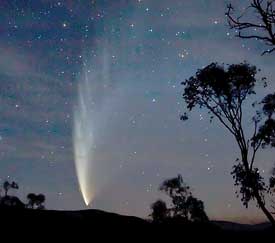Comets are made of the most primitive material in the solar system. As hunks of rock and ice that never coalesced into planets, they provide researchers with clues to the evolution of solar systems.

A chance encounter between spacecraft Ulysses and comet McNaught’s ion tail has scientists in the College of Engineering marveling at a stroke of luck and some surprising data.
The NASA/European Space Agency spacecraft Ulysses is on a mission to study the sun’s polar regions. In February, it flew through comet McNaught’s ion tail 160 million miles from the comet’s core. McNaught is the brightest comet observed from Earth in the last 40 years.
Instrument readings showed there was “complex chemistry” at play, says space science professor George Gloeckler, one of the authors of a paper on the findings published Oct. 1 in Astrophysical Journal.
Gloeckler is the principal investigator on the Solar Wind Ion Composition Spectrometer (SWICS) aboard Ulysses, which measured the composition and speed of the comet tail and solar wind.
SWICS found that even at 160 million miles from the comet’s nucleus, the tail had slowed the solar wind to half its normal speed. The solar wind usually would be about 435 miles per second at that distance from the sun, but inside the comet’s ion tail it was less than 249 miles per second.
“This was very surprising to me,” says Michael Combi, a space science professor who also is an author of the paper. “Way past the orbit of Mars, the solar wind felt the disturbance of this little comet. It will be a serious challenge for us theoreticians and computer modelers to figure out the physics.”
In 1996 Ulysses passed through the tail of comet Hyakutake and measurements indicated its tail didn’t slow the solar wind at all.
Solar wind is blamed for the lack of an atmosphere on Mars and for geomagnetic storms that can cut out power on Earth. It is a major component of space weather, which scientists study because if affects satellites and humans in space.
As for what these observations say about the origins of the solar system, scientists don’t know just yet.
“The composition of comets tells us about conditions approximately 4.5 billion years ago when the solar system was formed,” Gloeckler says. “Here we got a direct sample of this ancient material which gives us the best information on cometary composition. We’re still in the process of figuring out what it tells us.”
Space science professor Thomas Zurbuchen, another U-M author of the paper, likened Ulysses’ pass to putting your hand in the waters of Lake Michigan and pulling out a fish.
“That’s a pretty unlikely thing,” Zurbuchen says. “And that is a lot like what happened when we caught the tail of a comet that happened to pass very near the sun.”

